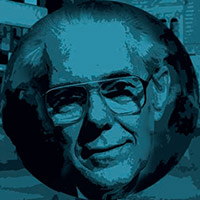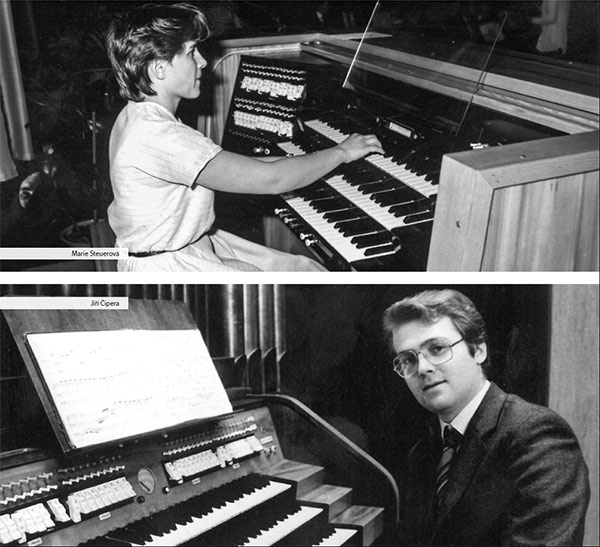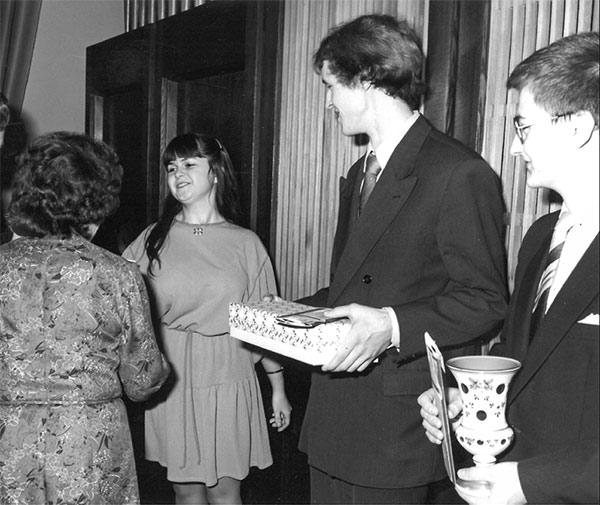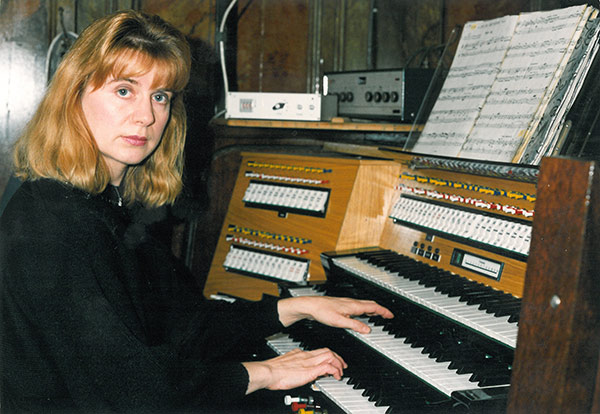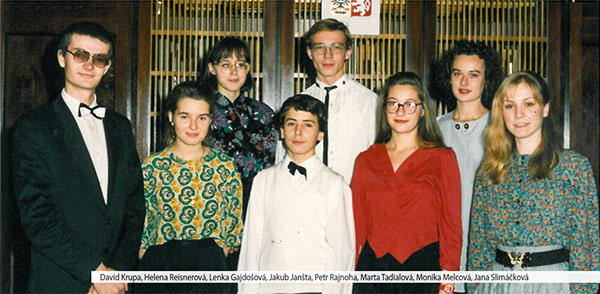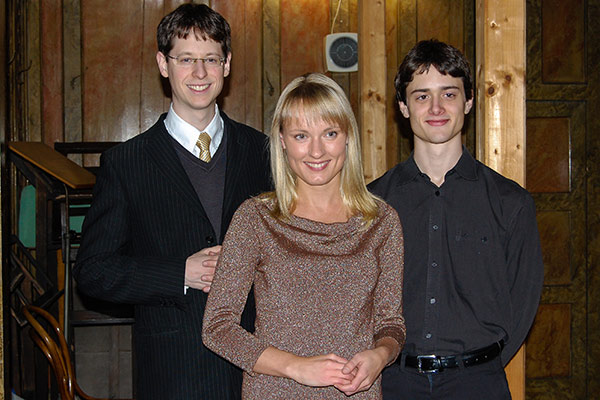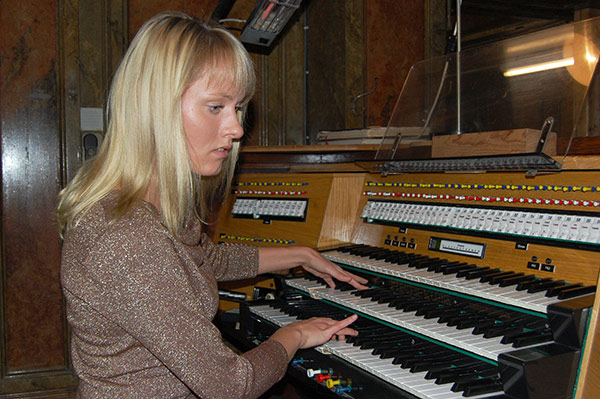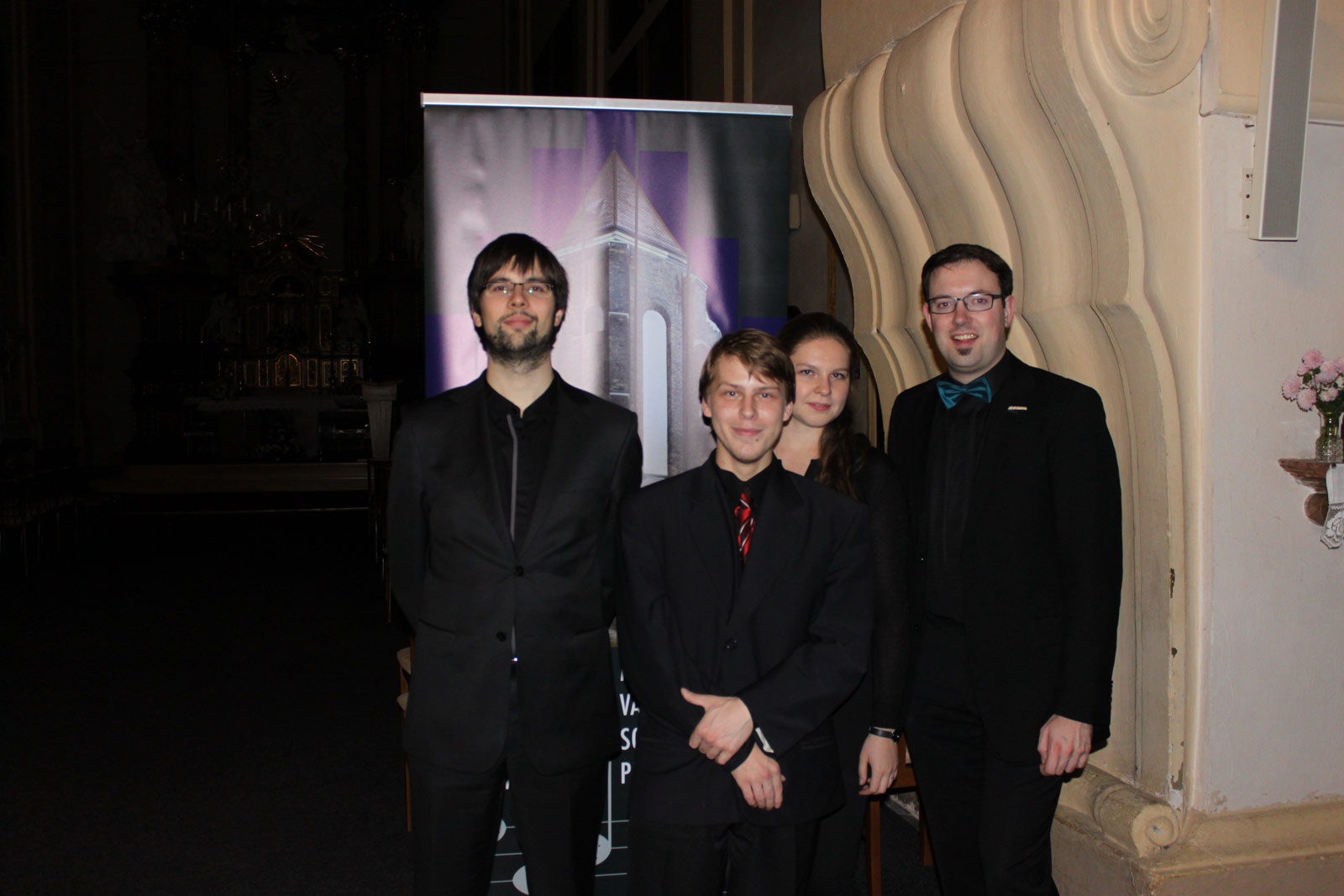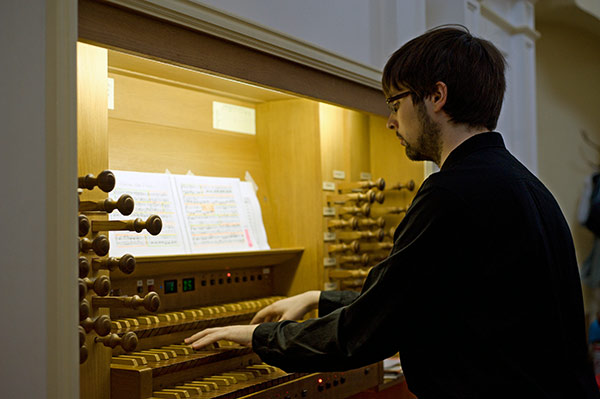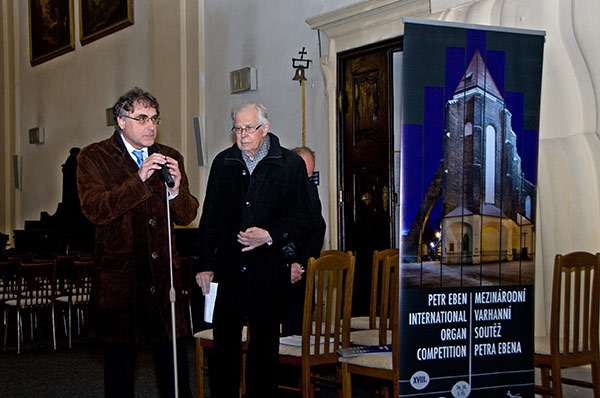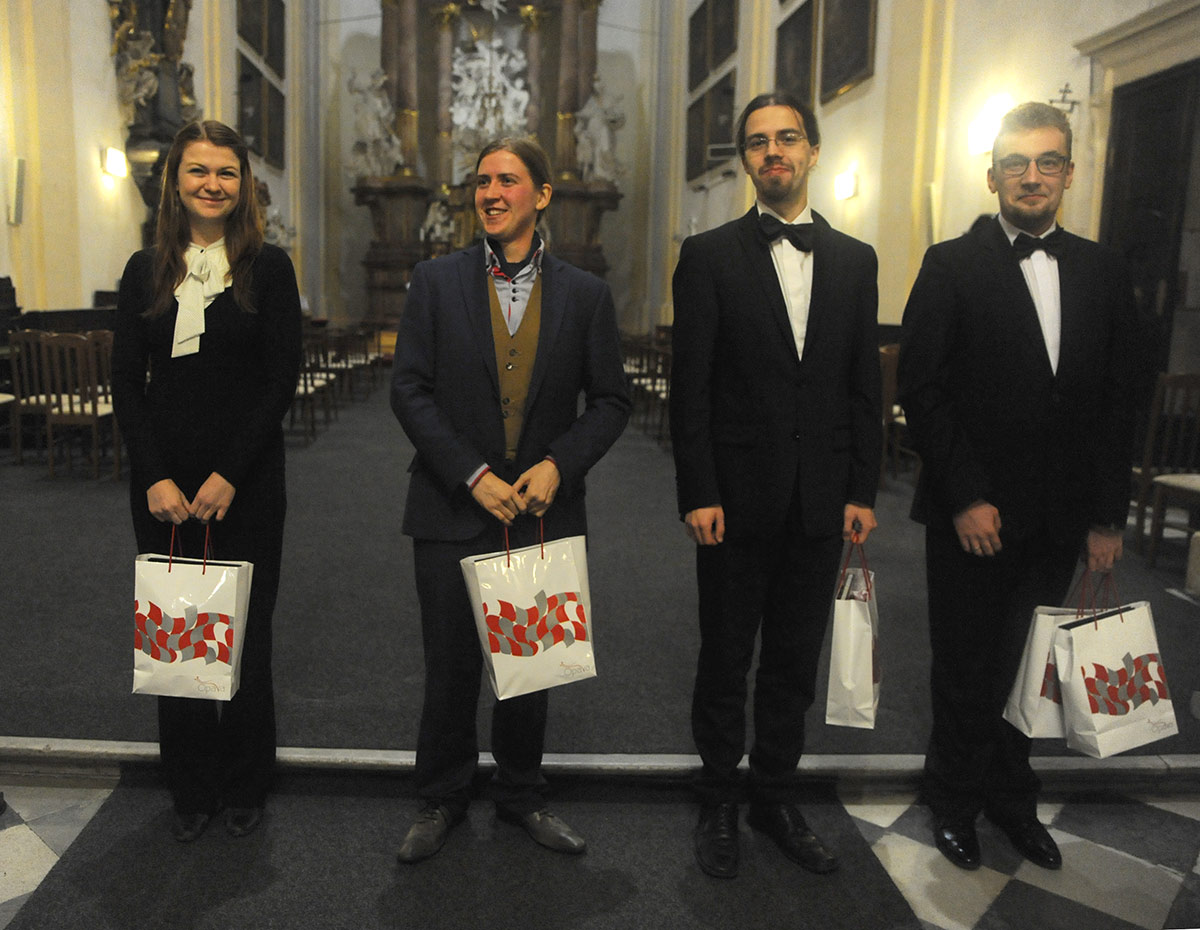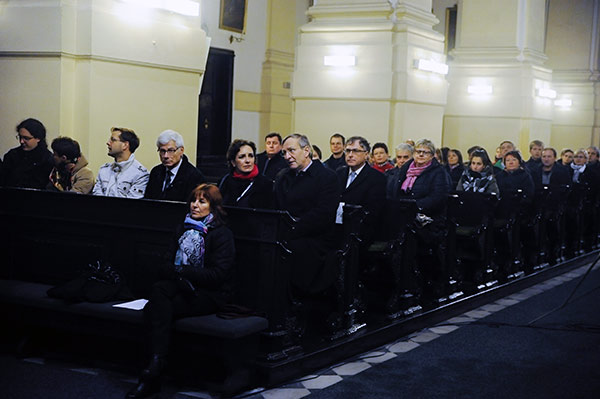Organ and the music life in Opava
Organ music represents an inseparable part of the cultural life in Opava, and we can say that it is not an unimportant role. Organ and the organ-making tradition in the region date back many centuries. The oldest documented record comes from the end of the 16th century (ca. 1596); it names an organ master from Opava, Ignác Eckhart. The organ making in Silesia was highly popular in the 17th and 18th century when the emergence and development of castle residences called for a rise in the production of music instruments, predominantly violins and organs, which spread mostly in the Jeseník Region. an important tradition of establishing organ workshops grew also in Opava. After the Thirty Years' War, the Ryšák Family (Jakub, Ignác, Kristina, Ferdinand Ignác) started an organ-making tradition in town, followed by the work of Václav Thiel, Antonín Staudinger – a member of an organ family line from Andělská Hora, and František Horčička Jr. Organ workshops were set up in Opava even after Staudinger had left for Fryštát and Horčička for Frýdek. From the 1820s there were organ workshops in Opava ran by the organ makers Wolfgang Brustmann and Karl Kuttler.
The Silesian organ making represents an important notion not only in the music historiography, but also in the present. Although the Silesian organ-making tradition crystallised primarily in Krnov, the roots reach all the way to Opava.
Apart from the organ making itself, there is also a history of organ playing in Opava. The Baroque chronicles of religious orders list both religious and secular brothers, who played the organ during the services. in the years 1647–1655, the organist Jiří Jandešovský played the organ in the Minorite Church of the Holy Spirit. At the turn of the 18th century, the position of the main organists in the church was taken by a lay brother Masimilian Linder Sveva. in 1710, an outstanding musician and composer and excellent organist Marian Welscher joins the Minorite church in Opava. From the second half of the 18th century, musicians from the nearby castle music bands performed in figural masses. Another important figure in the history of organ music in Opava was a choirmaster and organist Josef Schmitz.11 During the revival period, Jan Žiwsa, an outstanding organist and choirmaster in the Church of the Assumption of Virgin Mary, whose parsonage was in the possession of the Teutonic Order. The choir was ran by a choir singer Pavel Křížkovský.
The aforementioned stimuli for the organ tradition in Opava and Opavian Silesia remained relevant in the 20th century and they still hold importance today. The values of the past reflect period specifics of the present, and they are open to new opportunities. Despite the completely different social conditions and a newly formed cultural milieu, they draw attention of a wider Opava audience to prestigious organ festival projects as well as regular concert series, not only in the traditional sacral, but also in the secular environment.
The rich history of the Silesian organ making has become the foundation and a starting point for the formation of a new dramaturgical plan with a public presentation of the regional organ-making and organ-playing traditions. This tradition was resumed as early as 1973 when the musicological department at the Silesian Museum in Opava prepared an exhibition “Krnov Organs” to celebrate 100 years of Umělecký závod na stavbu varhan, Varhany Krnov (Rieger-Kloss) (Organ-making Art Company, Varhany Krnov), in which it documented the tradition of the Silesian organ making. The exhibition mapped the history as well as the present of organ making in Krnov. One of the exhibits was a newly made three-manual organ with 39 ranks built by the Krnov organ makers on the 100 years anniversary under the opus number 3412 for a conservatoire in Bratislava. Renowned organ players – teachers at the Czech and Slovak universities and conservatoires played the organ in September and October 1973 during an organ festival of a national importance – as a part of the 16th year of a multi-genre festival Bezruč’s Opava. The organ festival was then directly followed in November and December 1973 by The Festival of Young Slovak Organists, an event initiated by Irma Skuhrová, a professor at a conservatoire in Bratislava. The festival offered a series of organ matinees and full-length organ recitals given by the students of Slovak art schools – conservatoires and The Academy of Performing Arts in Bratislava.
A favourable response to these first Opava organ activities on the national level became the main incentive to further expand on the dramaturgical plan from 1973. The expansion took the form of regular concert series, and it culminated in a prestigious competitive presentation of the organ youth first on a regional, then national, and finally European and international level. in 1978 these activities led to the first year of a regular biennial competition – The Competition of Young Organists, in which the competitors performed on Rieger-Kloss Opus 3485 built for the purpose in 1978 and placed in the ceremony hall of Petr Bezruč Town Culture House.
From the Competition of Young Organists to Petr Eben International Organ Competition - a new phenomenon in the music life of Opava
Towards the end of the 1970s when a new organ was installed in the ceremonial hall in Petr Bezruč Town Culture House, the time was ripe for a new competition to be established in the music-loving town of Opava. The Competition of Young Organists represented a new chapter in the music life which boasted a long tradition and had a solid background in the town.
The Competition of Young Organists started in 1978 when the conditions for organ music were not particularly favourable; organ music was tabooed by the political regime of the time, it was largely inaccessible to a wider audience and only played in churches during services. The beginnings were not easy, and they were complicated by an artificial, but “compulsory” link to the activities of the boards for civil affairs. The competition was brought to life thanks to an unusual cultural partnership of three Silesian and North Moravian towns – Opava, Krnov, and Ostrava. Opava, represented by Petr Bezruč Town Culture House, the Organ-making Art Company in Krnov, and Folk Conservatoire in Ostrava provided an organisational, technical, and methodical background, which helped keep this extraordinary competition project in the region and ensure its staying power.
The biennial “organ Opava” competition is held in even years. From the beginning, the high standard of the competition has been guaranteed by prominent music teachers from our (Czech and Slovak) elementary and secondary schools and universities later joined by foreign music teachers and artists in the competition jury. Starting with the first years of the competition, the main organiser and announcer of the Competition of Young Organists was the Municipal Office in Opava (today The Statutory Town of Opava, from the 1st to the 20th year), in cooperation with the Organ-making Art Company, Varhany Krnov (from the 1st to the 11th year), and the Folk Conservatoire in Ostrava (from the 1st to the 11th year). The competition was also realised in cooperation with the Municipal Office in Krnov (from the 3rd to the 7th year), Didabit – an educational and cultural centre in Opava (8th and 9th year), Matice slezská (10th and 11th year), Breda Holding a.s. (12th year), Association for Art and Education Talent in Ostrava (15th year), and Secondary Church Organ School – today Church Conservatoire in Opava (from the 14th to the 20th year). The competition would not exist without the help of various supporters. in some years the competition received grants from regional institutions, and it was regularly subsidized by the Ministry of Culture of the Czech Republic.
Supporting Czech and Slovak organ compositions has always been the most important aspect of the conceptual framework of the competition. ČHF (Czech Music Fund) Prague (from 1994 The Foundation of the ČHF, from the 1st to the 20th year), SHF (Slovak Music Fund) Bratislava (from the 2nd to the 8th year), The Foundation Artist’s Life (11th year), and Bohuslav Martinů Foundation (11th and 13th year) financially supported the competition. The interest of our contemporary composers in the royal instrument grew considerably in the course of the first five years of the competition. in 1986 the composer Petr Eben was called to cooperation by the organisers of the competition. This initiative resulted in a beautiful present – at the beginning of the 5th year, the Master dedicated three organ miniatures to the competitors. The miniatures later became a part of a series of ten miniatures Momenti d´organo. The participants of the 5th year received a facsimile of one of the miniatures as a commemorative certificate.
To the initiators and organisers’ credit, we can say today that the original concept of the competition was far-seeing and fruitful; in the course of the preparation for each year of the competition, the organisers always reflected the current situation at home and abroad. Educational aspects always played an important part when stating the conditions of the competition and dividing categories.
From the 1st (1978) to the 6th (1988) year, the Competition of Young Organists had two categories and two rounds with the age limit of 26 years reached on the first day of the competition. The first category was for the pupils of Czech and Slovak Folk Arts School, students of folk conservatoires, students who took private classes, and for autodidacts. This category was devoted to the contestants without professional ambitions, for whom organ music represented a free-time activity and who otherwise studied or worked in a different field. The second category was for Czech and Slovak students and graduates of secondary music schools; this category represented a step towards the highest national Interpretative Competition of the Ministry of Culture of the Czechoslovak Republic, which was intended mostly for students and graduates of art universities. Every year of the competition started with a concert given by the winners of the previous year, and ended with a concert performed by the current year’s winners.
The 1st year of the Competition of Young Organists in 1978 started unconventionally with an impressive performances of nine members of the competition jury, who performed for the competitors and the Opava audience.
In the 3rd year (1982) of the competition, a new category was added – an optional discipline of improvisation, which stood independently of the interpretative part of the competition.
From the 5th year (1986), the prestige of the competition started growing, with the Ministries of Education of the Czechoslovak Republic and the Soviet Socialist Republic, and the Ministry of Culture of the Czechoslovak Republic assuming patronage of the competition. Performers from abroad started to show interest. Wacław Kubicki, a professor at Akademia Muzyczna im. Stanisława Moniuszki in Gdańsk, joined the jury in the fifth year of the competition, and he started the year with a recital. The organising team initiated cooperation with Koszaliňskie Towarzystwo Muzyczne, which invited the winner of the fifth year of the competition, Pavel Maňásek, to perform in Gdańsk. The fifth year of the competition included an exhibition on the trends in organ making in the Czechoslovak Republic and abroad, which was organised by the Organ-making Art Company, Varhany Krnov in the cloister of Petr Bezruč Town Culture House.
The Krnov organ company actively participated in the 6th year of the competition Opava ’88, when a part of the competition took place in the concert hall of a renovated Church of the Holy Spirit in Krnov on a new organ with a jubilee number 3600 made by the Rieger-Kloss organ company. The repeats of the opening and closing concerts of the competition winners, which included the improvisation competition, met with a favourable response from the experts and the public alike.
The 7th year of the competition in 1990 brought (along with unexpected political changes) new perspectives and new views of organ art. The competition started with a high-quality performance given by Susan Landale, a French organist of Scottish origin. The concert was repeated in several places in the region (Krnov, Fulnek, Polanka nad Odrou). The performance in Opava was based on pieces composed by outstanding 20th century Czech and foreign organ composers. The concert featured a premiere of the first part of Peter Eben’s cycle Biblical Dances. After the concert, Petr Eben dedicated this part of the cycle to Susan Landale. The second category of the competition underwent a radical change in this year of the competition. It was newly split into two groups, which reflected the two-level conservatoire system (the first group was designated for the students of the 1st to 4th grade, the second group for the students of the 5th and 6th grade, including conservatoire graduates).
In the 8th year of the competition Opava '92, another foreign jury member performed at the beginning of the competition. Zsuzsi Eleke's participation was arranged by the Hungarian Cultural and Information Centre in Prague. For the first time in the history of the competition, the opening concert took place in a sacral space, which is the best place for organ music. Elekes’ concert in the Church of the Assumption of Virgin Mary in Opava was the highlight of not only the competition, but the whole concert season in Opava. The outstanding performances of the competitors in the improvisation category also took place in the church.
The renowned French charm was manifested in the improvisations performed by an organist from Dijon, Sylvain Pluyaut, who gave concert in the parish church in the middle of the competition week in the 9th year of the competition Opava ’94. The professor of organ from the Cathedral School in Dijon improvised on his own themes, as well as the themes of his fellow jury members. He joined the jury to assess the performances given by the competitors in the second category. More than sixty contestants in this year’s competition proved the ever increasing interest in the Competition of Young Organists after 1990. The growing numbers of competitors reflected not only the growing numbers of conservatoires in our lands, but also the favourable conditions of the competition with a less restricted choice or repertoire. Both teachers and students always valued the openness and objectivity of the competition, which was from the beginnings of the competition guaranteed by the fact that the jury always made the scoring system and the points scored by the individual contestants public. The jury members also instructed the competitors and analysed their performances with them. The organising team provided methodical materials
The number of contestants reached a new high in the jubilee 10th year of the Competition of Young Organists Opava ’96. The existing division of the competitors into two categories with the second category subdivided into two groups changed into three categories. The first two categories remained largely the same; the third category, which included students and graduates of the 5th and 6th grade of Czech and Slovak conservatoires, was extended to include Czech and Slovak art universities. a repeat of the concert of winners took place in the Polish Raciborz. a renowned British organ and cembalo player, Douglas Hollick, joined the jury. His innovative recital dramaturgy and his imaginative and exciting performance in the Chapel of Holy Cross in Opava on a copy of a Baroque spinet and positive organ was a perfect example of stylistically clean and historically accurate period interpretation of Baroque keyboard compositions by authors from the Protestant north, Catholic south, and classicising France.
In the 11th year of “organ Opava” ’98, the organisers of the Opava competition established cooperation with the organisers of the International Organ Festival in Oliwa through a member of the jury, Roman Perucký, a general intendant of the Baltic Philharmonic Orchestra in Gdańsk. The winner of the 3rd category, Bernardetta Šuňavská from the Academy of Performing Arts in Bratislava, was invited to perform at this prestigious festival in 1999. in the twenty years of the existence of the competition, the alternation of generations took place, and the winner of the first category in the first year of the competition, Tomáš Thon, joined the jury in the 11th year of this competition.
The organisers made more changes in the 12th year of the representative parade of the organ youth “Opava 2000". The competition newly took place in October instead of the raw and harsh November. With the jury being international, the third category newly welcomed contestants from all over the world. From this year onwards, the winner of the competition performed in the following concert season in the Opava cycle of concerts for subscribers. The demanding competition of Czech and foreign contestants was livened up by a performance given by Guy Bovet, a Swiss jury member. The multicoloured dramaturgy – starting with the performer’s own compositions inspired by the third flow music in the synthesis of jazz with classic genres (4 sacred tangos) to an unrivalled organ transcript of Ravel’s fairytale ballet Mother Goose – appealed to the audience in the Co-cathedral of the Assumption of Virgin Mary.
In the 13th year of the international Competition of Young Organists “Opava 2002”, the third category was transformed to represent a unique competition model. The main incentive for the change from a two- to three-category competition came as a result of the installation of a new organ in 2000 in the Minorite Church of the Holy Spirit in Opava.
Given the disposition and sound characteristics of the instrument close to the Baroque aesthetic principles, it was possible to assign 16th to 18th century compositions for round two of the competition. Such a specific delimitation of the second round made the organ Opava of 2002 a promoter of progressive tendencies in the sphere of historically informed period interpretation. This trend was further reinforced when the International Organ Festival of Baroque Music was founded in 2001.15 The eliminating first round of the competition on the Rieger-Kloss organ with a universal disposition in the ceremonial hall of Petr Bezruč Town Culture House included one of Bach’s choral trios and a selection of parts of suit cycles of the 20th century French authors J. Alain and J. Langlais.
For the first time in the history of the competition the finals took place in the Co-cathedral of the Assumption of Virgin Mary. Apart from the compulsory Vigil H 382 by Bohuslav Martinů, the list included compositions from cycles by Czech and German Romantic authors with an overlap to the 20th century, and a composition or a cycle by a Czech Modernist composed after 1945. The prevailing dramaturgy of the first and third round of the competition was complemented by a concert featuring 19th and 20th century French and Belgian authors given by the French (born Scottish) organist Susan Landale. The winner of the third category regularly performed in the following concert season – the cycle Jeunesses Musicalles, Janáček’s Philharmonic Orchestra Ostrava.
The ever increasing prestige of the competition in Opava is evident in the subtitle of the 14th year of the International Competition of Young Organists 2004 – Petr Eben’s Competition. Adding the composer’s name to the title of the competition reflects the fact that Eben, who visited Opava many times, accepted the position of an honorary jury chairman in the 14th year of the competition. Before the competition, Petr Bezruč Town Culture House held an exhibition called “Petr Eben – a Pilgrim in the Labyrinth of the World and the Paradise of Music”. The author of the project was Kateřina Vondrovicová, who also authored the first monograph on the composer. The exhibition opening was followed by Eben’s last organ, originally improvisation, cycle inspired by John Amos Comenius’ The Labyrinth of the World and the Paradise of the Heart. The concert took place in the Co-cathedral of the Assumption of Virgin Mary and was performed by Tomáš Thon, an organist from Opava. Fourteen segments were interspersed with the recitation of selected passages from Comenius’ book read by Marek Eben.
The programme instructions of individual categories of the 15th International Competition of Young Organists Opava 2006 were based on the previous year’s instructions (13th and 14th year); with Petr Eben’s compositions or selected cycle pieces added to the list for the first and final rounds of the second and third category. The improvisations of the second and third category were also based on Eben’s compositions, but not those taken over from the organ repertoire. Starting this year, the foundation Czech Music Fund has been rewarding the best performance of Petr Eben’s composition with a monetary award. The international third category increasingly attracted attention of young foreign organists; 40 competitors from three continents registered for the 15th year of the competition.
The 16th year of Petr Eben’s International Organ Competition – The Competition of Young Organists Opava 2008, was the last year that featured the model of the first and third category for contestants up to 26 years of age, and the second category up to 19 years. The beginning of the competition in the Co-cathedral of the Assumption of Virgin Mary was truly symbolic, and not only from the dramaturgic point of view, but also in terms of interpretation. The opening concert Musica Antica e Moderna – a Homage to Petr Eben commemorated Petr Eben’s (22 Jan 1929 – 24 October 2007) two most significant forms of his work, that is vocal and organ music. The performers presented also Gregorian chants, which were a great inspiration to the composer. The pieces were performed by artists who were close to the Master’s composition style and able to capture its inmost spiritual and structural essence. The chants were presented by Schola Gregoriana Pragensis led by David Eben, organ compositions were played by Tomáš Thon. This year’s competition featured also an organ recital given by the jury chairman Halgeir Schiager, a Norwegian organist close to Petr Eben’s work. Schiager cooperated with Eben when he was recording his complete organ work for the music label Hyperion.
The 17th year of Petr Eben International Organ Competition Opava 2010 had the form of only one, but well represented category for organists up to 30 years of age. It attracted 51 young organ players including improvisers from many European countries and from Asia.
The contestants played three dispositionally different instruments – the organ in the ceremonial hall in Petr Bezruč Library (formerly Petr Bezruč Town Culture House), the Church of the Holy Spirit, and the Co-cathedral of the Assumption of Virgin Mary. The jury members were outstanding teachers and artists, many of whom were close to Eben and his work. Eben consulted and authorised his compositions with many of them (Susan Landale, Józef Serafin, Johannes Geffert, Ferdinand Klinda, Irena Chřibková, Věra Heřmanová). The competition started on the third anniversary of Eben’s death with a concert given by a Polish organist Józef Serafin.
The 18th year of Petr Eben International Organ Competition Opava 2014 started with a concert by Johaness Geffert, a professor of organ play and improvisation at Hochschule für Musik und Tanz in Cologne upon Rhine. The concert took place in the Church of the Holy Spirit on the aforementioned organ with a disposition and sound characteristics close to the Baroque instruments of south German and French provenance.
Geffert played Baroque and classicist pieces, as well as pieces from Eben’s cycle Faust, showing the audience how “universal” Eben’s music is and how his music can be adapted to fit historical setting.
The seven-member jury, which was chaired by Ferdinand Klinda, included an Austrian organist, composer and musicologist, Thomas Daniel Schlee, who looks after Eben’s composition heritage by publishing his works in Universal Edition. The jury assessed the performances of 51 interpreters, including 11 improvisers, from four continents – from South Korea to Philadelphia.
The 19th year of Petr Eben International Organ Competition Opava 2016 did not bring any substantial changes regarding the competition rules or conditions. The only change was to give the contestants more freedom to choose a piece for the final round of the competition, which is one of the criteria for the assessment of the performance; it involves choosing a suitable piece for the given instrument.
The change of conception attracted a higher number of competitors, especially in the improvisation category. The jury, which included three winners from the previous years (Bernadetta Šuňavská, Petr Čech, Balázs Szabó), assessed the performances of almost 50 contestants. This year of the competition met the expectations and proved the viability and the irreplaceability of Petr Eben’s work in the repertoire of the young generation of organists. Thanks to Petr Eben International Organ Competition, his work will stay in the repertoires of organists all over the world.
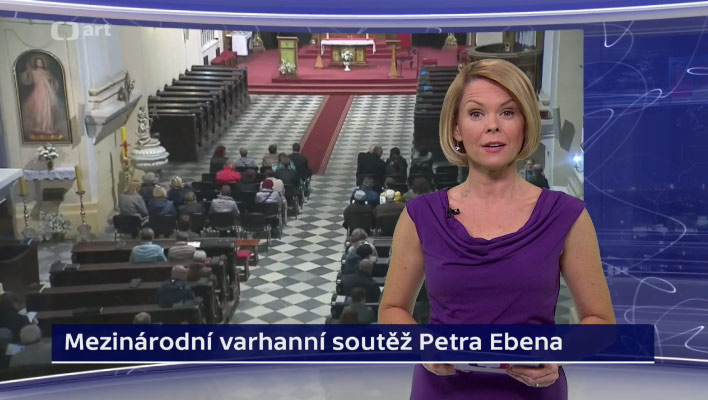
The jubilee 20th year of Petr Eben International Organ Competition Opava 2018 is a culmination of a forty-year continuity of the Opava competition. The increasing number of contestants from faraway countries is a testament to the socio-cultural values of the competition, as well as its importance for the Czech and international organ world. Organ interpreters and improvisers from the Central-eastern part of Europe will compete with contestants from Western Europe and two other continents. This year’s jury reflects the generation shift. Three jury members are winners from previous years of the competition: Pavel Černý in 1988 and 1990, Monika Melcová in 1990 and 1992, Petr Rajnoha also in 1992. Monika Melcová, who teaches organ improvisation at the music academy Musikene – Centro Superior de Música del Pais Vasco in the Spanish San Sebastian, will open the festival with a concert in the Church of Holy Spirit, presenting Spanish, French and Italian Baroque compositions and also her own improvisation. The winners of main awards for interpretation and improvisation will perform at prestigious international festivals – Leoš Janáček International Music Festival Ostrava 2020, International Organ Festival Audite Organum 2019 in the Basilica of St. James in Prague, Bratislava Organ Festival 2019, and at Chorzowski Festival Muzyki Organowej i Kameralnej Organy Plus 2019.
The forty years of existence of Petr Eben International Organ Competition, its importance in the society, and its popularity among young organists and their teachers confirm the significance of the competition not only in the organ world, but also in the music life of the historical town of Opava.
PhDr. Jiří Čech, Ph.D.
